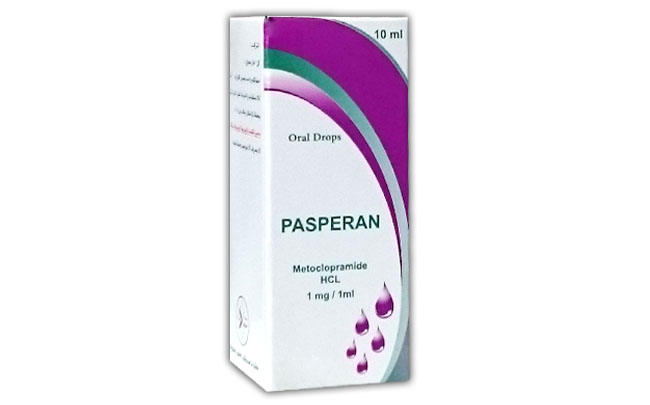Description:
PHARMACEUTICAL EFFECTS:
Gastro-intestinal Action:
PASPERAN seems to sensitise tissues to the action of acetylcholine. PASPERAN increases the number, strength and activity of gastric antral contractions and also producing an increase in the strength of duodenal contractions.
These changes increase the speed of gastric emptying and reduce reflux from the duodenum and the stomach into the oesophagus. Which has been observed radiologically and by other methods PASPERAN simultaneously increases the motor action of the small intestine which results in a decrease in the small bowel transit time.
PASPERAN has no effect on gastric secretion PASPERAN has an effect on the gastro-oesophageal junction of the stomach. Producing an increase in cardiac sphincter pressure.
Anti-Emetic Action:
PASPERAN acts on the chemoreceptor trigger zone to produce a central anti-emetic effect
INDICATIONS:
Adults (20 years and over):
-Digestive Disorders: PASPERAN is of value in conditions associated with gastric stasis or hypomotility.
-Nausea and Vomiting: PASPERAN is an effective anti-emetic agent in the control of nausea and vomiting associated with the following conditions:
– intolerance to essential drugs possessing emetic properties.
-uraemic conditions.
-malignant disease.
-gastrointestinal disorders and post-anesthetic vomiting.
-Diagnostic Radiology: In patients where delayed gastric emptying interferes with radiological examination of
the stomach and/or small intestine.
-Duodenal Intubation: The action of PASPERAN in promoting stomach emptying, combined with its anti-emetic effect, has proved a useful aid to gastro-intestinal intubation procedures.
Young Adults and Children:
The use of PASPERAN in patients under 20 years should be restricted to the following:
Severe intractable vomiting of known cause.
As an aid to gastro-intestinal intubation and diagnostic radiology
CONTRA INDICATIONS-
Animal tests in several mammalian species have shown no teratogenic effects but PASPERAN is not
recommended during pregnancy.
-Cases of hypertensive crises have reportedly been associated with metoclopramide after administration to patients with phaeochromocytoma.
-PASPERAN should not be given to patients with suspected or confirmed phaeochromocytoma.
-Where stimulation of muscular contractions might adversely affect gastro-intestinal conditions such as
gastro-intestinal. Obstruction or immediately after surgery.
-Hypersensitivity to any of the ingredients.
-Patients with convulsive disorders
SIDE EFFECTS
Various extrapyramidal dystonic-like reactions could occur. Especially in children and young adults. The findings include spasm of facial and/or extra ocular muscles, trismus, a bulbar type of speech and unnatural positioning of the head and shoulders. There may be a general increase in muscle tone.
Hypotension, hypertension may occur and there are isolated reports of blood disorders, hypersensitivity reactions, and urinary incontinence.
Parkinsonism has been reported during prolonged therapy and long-term treatment should be regularly reviewed.
Less frequent occurrences of the neuroleptic malignant syndrome have been reported. This syndrome is
potentially fatal and comprises hyperpyrexia, altered consciousness, muscle rigidity, autonomic instability and elevated levels of Creatinine phosphokinase and must be treated urgently (recognised treatments include dantrolene and bromocriptine). Metoclopramide should be stopped immediately if this syndrome occurs.
Diarrhoea or constipation has been reported. PASPERAN stimulates serum prolactin levels, and may cause breast engorgement, galactorrhoea, lactorrhoea or related disorders.
The conditions return to normal after withdrawal of the drug.
Transient increases in plasma aldosterone concentrations have been observed
PRECAUTIONS
-Care should be exercised in patients being treated with other centrally active drugs e.g. in epilepsy
– Increase in the risk of amovement disorder Known as Tradive dyskinesia
-Tardive dyskinesia usually appears as involuntary movements of the tongue, face and cheek. These movements can cause lip biting, or sticking out of the tongue, or leg shaking.
The risk increases with longer treatment and is higher in the elderly, especially elderly women.
There are no known treatments for Tradive dyskinesia and it is irreversible with long-term treatment ( over 12 weeks ).
-less frequently, tardive dyskinesia can develop with short term treatment at low doses; in these cases, the symptoms are more
likely to disappear either partially or completely over time, once treatment has been stopped.
-Metoclpramide treatment beyond 12 weeks should be avoided, unless the benefit is judged to outweigh the risk.
-In patients with clinically significant degrees of renal or hepatic Impairment. Therapy should be at a reduced dosage.
-Care should be taken when medication causing extrapyramidal side-effects such as phenothiazines, are taken concomitantly.
-The neuroleptic malignant syndrome has been reported with metoclopramide in combination with neuroleptics as well as with metoclopramide monotherapy
Lactation:
Since metoclopramide is found in breast milk, ‘the risk-benefit must be considered.
DRUG INTERACTIONS
-Anticholinergic agents and opioid analgesics may antagonise the gastro-intestinal effects of metoclopramide. The effects of central nervous system depressants may be enhanced.
-Metoclopramide may affect the absorption of other medicines by either diminishing absorption from the stomach or by enhancing absorption from the small intestine.
-As both PASPERAN and the phenothiazines may cause dystonia, care should be exercised in the event of both drugs being prescribed concomitantly
DOSES
-The dosage recommendations given below should be strictly adhered to if side-effects of the dystonic type are to be avoided.
-It should be noted that total daily dosage of PASPERAN, especially for children and young adults, should not normally exceed
0.5 mg/kg body mass.
-PASPERAN should only be used after careful examination to avoid masking an underlying disorder, e.g. cerebral irritation.
-In the treatment of young adults and children attention should be given primarily to body mass and treatment should commence at the lower dosage where stated.
-Orally: (at least 30 minutes before eating)
Liquid presentation should be used in the younger age groups as this facilitates accurate dosage and administration
-Adults 15 years and over, with a mass of 60 kg or more:
10 mg (1 x 10 mg tablet or 10 mL of 5 mg/5 mL syrup) 3 times daily.
-Adults 15 years and over, with a mass of less than 60 kg:
5 mg (0.5 x 10 mg tablet or 5 mL of 5 mg/5 mL syrup) 3 times daily.
– Children 9 – 14 years (30 kg and over):
5 mg (0.5 x 10 mg tablet or 5 mL of 5 mg/5 mL syrup) 3 times daily
– Children 5 – 9 years (20 – 29 kg):
2.5 mg (2.5 mL of 5 mg/5 mL syrup) 3 times daily
Per Rectum (Supp.):
-Adults 15 years and over, with a mass of 60 kg or more:
10 mg (1 x 10 mg suppository) 1 – 3 times daily
– Adults 15 years and over, with a mass of less than 60 kg:
5 mg (1 x 5 mg suppository) 1 – 3 times daily
– Children 9 – 14 years (30 kg and over):
5 mg (1 x 5 mg suppository) 1 – 3 times daily
– Children under 9 years:
No suitable preparation available
OVERDOSAGE
-Overdosage of PASPERAN could give rise to the dyskinetic reactions manifested as motor restlessness, agitation; irritability, spasm of facial and neck muscles and the muscles of the tongue. In severe cases opisthotonus can result.
-Very seldomly AV block has been observed.
-Overdosage should be treated by gastric lavage with appropriate supportive measures.
Should active therapy be required for a dystonic reaction, an anti-Parkinson drug may be used. Further treatment is symptomatic and supportive.
STORAGE CONDITIONS
PASPERAN suppositories: Keep tightly closed and store in a cool dry place (below 25°C).
PASPERAN coated tablets: Keep tightly closed and store in a cool dry place (below 25°C).
PASPERAN syrup: Keep tightly closed and store in a cool dry place (below 25°C).protect from light.
PASPERAN oral drops: Keep tightly closed and store in a cool dry place (below 25°C).
PACKAGING:
PASPERAN suppositories children: Box of 6 suppositories.
PASPERAN suppositories adults: Box of 6 suppositories.
PASPERAN coated tablets: Box of 20 coated tablets.
PASPERAN syrup: bottle of 100 mL.
PASPERAN oral drops: Dropper bottle of 10 mL (Each 1 mL = 20 drops)

